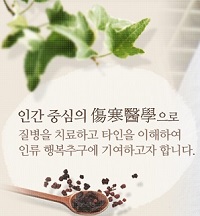『傷寒論』辨病診斷體系에 근거하여 桂枝甘草龍骨牡蠣湯 투여 후 호전된 안면홍조 치험 1례
Case Report of Facial Flush Treated by Gyejigamchoyonggolmoryeo-tang Based on Shanghanlun Provisions
김연주 ((재)제주한의약연구원)
이상기 (정방한의원)
Abstract
- keywords
- Facial flush, Hot flush, Gyejigamchoyolgolmoryeo-tang, Shanghanlun
참고문헌
1.Kim DI, Kim SW, Kim JW, Kim CW, Yoon MH, Lee TK, et al. Korean traditional medicine gynecology & obstetrics. Seoul:Jeong Dam. 2001:218-34.
2.Song MJ, Joe SH, Jung HG. Characteristics of middle aged depressed women with hot flushes. Korean journal of psychosomatic medicine 2017;25(2):176-84.
3.Yoo HK. Hot flush and sweating: recent pathology, diagnosis and treatment. J Korean Soc Menopause. 1996;2(2):132-46.
4.Miller HG, Li RM. Measuring hot flashes:summary of a national institutes of health workshop. Mayo Clinic Proceedings. 2004;79(6):777-81.
5.Han JM, Kang NR, Ko WS, Yoon HJ. The study on the korean and western medical literature for skin aging-wrinkle, hyperpigmentation, dry skin, facial flush. J Korean Med Ophthalmol Otolaryngol Dermatol. 2014;27(2):1-13.
6.Kim KH, Kim DI, Hwang DS, Lee JM, Kim HJ, Yoon HM, Jung HJ, Kang KW, Lee MS, Choi SM. Methodologic lessons learned from multicenter, randomized, controlled clinical trial of acupuncture for hot flashes in peri- and postmenopausal women. The Journal of Korean obstetrics & gynecology. 2010;23(1):42-52.
7.Kim BM, Jo HG. Administration progression and adverse event report of Er-xian decoction for menopausal hot flushes:case report and review of literature. J. Int. Korean Med. 2019;40(1):154-63.
8.Lee AR, Son SH, Park SJ. 3 cases of postmenopausal hot flush treated with Hwangryunhaedoktang-gamibang. J Korean Med Ophthalmol Otolaryngol Dermatol. 2017;30(4):176-83.
9.Cho JG, Seo S, Park SJ, Han SR. 3 cases of emotional facial flush treated with Gagamhwanggeum-tang. J Korean Med Ophthalmol Otolaryngol Dermatol. 2015;28(1):160-8.
10.Hwang GS, Jang CY, Lee SY, Kim JH, Woo C, Shin YJ, Sin SH. A case study of a stroke patient with hot flushes treated with traditional korean medicine. J. Int. Korean Med. 2016;37(5):691-7.
11.Ha HY, Lee JH, Lee SJ. A case report of hot flashes treated by herbal medicine based on Shanghanlun provision. J of KMediACS. 2015;7(1):127-32.
12.Lee SI, Cho HR. Comparison of shanghanlun. Seoul:KMediACs publishing house. 2015:32.
13.Suh HU, Hwang EY, Jung SY, Kim JW. A case of a panic disorder (with Agoraphobia) patient improved by herbal extracts–Gyejigayonggolmoryo-tang and Jakyakgamcho-tang. J. of Oriental Neuropsychiatry. 2010;21(4):207-18.
14.Jang HH. Clinical observations of 73 treatment cases of afferent neuron paralysis using Gyejigamchoyolgolmoryeo-tang. Chinese Medicine Clinical Observation. 2003;3:22-26.
15.Heo J, Cho SH, Lee SJ. Four case reports of neck pain based on Shanghanlun 燒針 provisions. J. K. Mediacs. 2018;10(1):95-114.
16.Lee SI, Cho HR. The comparisons of the Shanghaluns. Goyang:KMediACs Press. 2020:210.
17.Oriental obstetriscs and gynecology textbook compilation committee. Oriental obstetriscs and gynecology. Seoul:Jungdam. 2007:237-64.
18.Kim TY, Leem KH. Effects of Gyejigamchoyonggolmoryeo-tang on sleep latency and total duration of sleep induced by thiopental sodium in mice. The Korea Jounrnal of Herbology. 2020;35(6):29-34.
- 다운로드 수
- 조회수
- 0KCI 피인용수
- 0WOS 피인용수


